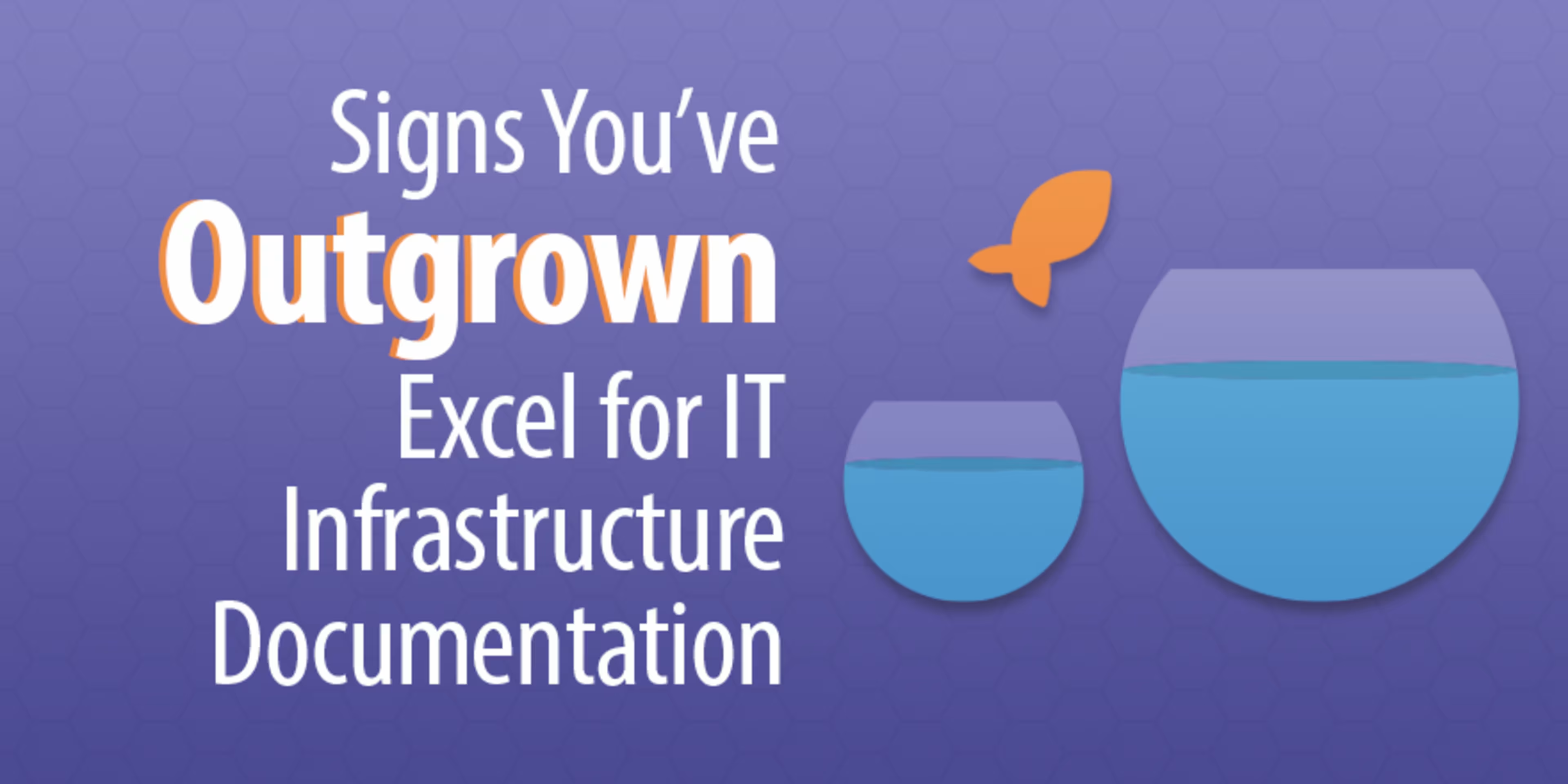If you're starting to feel like it's getting harder and harder to keep your IT infrastructure documentation up-to-date in Excel, it's not your imagination.
Excel is a great solution for small shops and startups; it's often the default system companies use when seeking cost-effective ways to keep track of information.
If you're searching for a documentation solution to match your rapid growth, however, an Excel template probably isn't what you need. While it can do wonders for businesses that lack organizational structure, Excel—and manual documentation, in general—doesn't scale well when it comes to documenting larger and quickly-changing IT infrastructures.

If your small business has a growth mindset, it's important to identify and resolve potential issues quickly. How can you tell when you're about to encounter an Excel documentation hurdle? Read on.
Do you need to upgrade your IT infrastructure documentation system?
It's no secret that Excel has limitations. It's a manual solution, and all manual solutions are error-prone. It doesn't support more than one editor at a time, and it's not ideal for extracting audit or compliance data.
It's not that Excel doesn't work; for smaller deployments, it's a great system. But the effort required to maintain accurate spreadsheets grows exponentially as your infrastructure grows.
These (and other) obstacles can quickly catch up with your business, and become persistent pain points. To combat this, keep an eye out for the following three indicators that you should upgrade to a purpose-built infrastructure documentation tool that includes automated discovery. (You can find these types of tools in Capterra's DCIM, CMDB, and ITAM directories.)
1. Your IT team is growing
On the surface, this sounds like a good thing. You're growing, and you need another engineer. It's a good problem to have, and means you're doing something right.
What are the downsides?
Bringing in a second engineer means you need to divide responsibilities. And sharing responsibilities requires the ability to collaborate, track issues, and allow each engineer to pick up where the other left off.
Why Excel won't work
Excel isn't great for collaboration. It can't exactly handle two editors working on the same sheet, or prevent employees from storing duplicate data in two different places (or two different formats).
Issue tracking also becomes a challenge when you add a second operations engineer. Excel doesn't prevent one engineer from doubling up on the same task, or allow easy tracking of each step along the way.
What to do: Use dedicated software to keep data consistent, automatically track changes, and normalize your workflow.
2. You're not ready for additional auditing and compliance requirements
As your company grows, you'll be subject to more and more regulations. You'll also be increasingly scrutinized by the customers you do business with. You need to be ready to be audited, and confident you'll pass muster.
To ensure audit readiness and ongoing compliance, your reports (and the information in them) must be consistent in both location and format.
Why Excel won't work
You can create templates in Excel, but they'll only get you so far. Simply providing a recommended template doesn't prevent people on your team from storing data elsewhere.
The chances of two employees recording the same non-standard data in the same format in two unique places? Slim to none.
What to do: Find a purpose-built tool to document your infrastructure. These tools record the same data in one place, continuously. They're often built with an audit focus, ensuring that they gather pertinent data and report on your compliance status.
3. Manual documentation is dragging you down, and you can't keep up anymore
The goal of bringing in an automated documentation system isn't to minimize human contact.
On the contrary: you want to make the process as useful and user-friendly as possible, maximizing the number of people who can benefit from the tool's efficiencies.
Why Excel won't work
Excel is only useful and user-friendly up to a certain point.
One of the main reasons documentation falls behind without a purpose-built ITAM or CMDB solution is because Excel and Visio don't scale. As the amount of required documentation grows, the work becomes more tedious, and opportunities for mistakes increase.
What to do: Purchase a quality, market-leading tool that is user-friendly at scale, meaning it can managed your workload and is more likely to be used. Keep in mind that the more people who know how to use a tool effectively, the more successful it is.
At the end of the day, that's what we're all after. Success in business, success in infrastructure documentation, and success in everything in between.
Have you suffered Excel-related growing pains?
Although Excel is a wonderful tool, it's important to recognize when it has outlived its usefulness. Arm your business with a proper DCIM, CMDB, ITAM, or ITSM solution before it's too late.
Your organization may have outgrown Excel differently than the ways detailed above, and startups will continue to uniquely outpace it in the future. As businesses become more reliant on accurate, real-time data, manual error-prone solutions are going out of style. And with the rising popularity of remote workers, solutions with no version control that can't be accessed via the cloud are becoming relics of the past.
What Excel-related growing pains has your business experienced? Share them in the comments below!
If you're ready to start shopping for a non-Excel documentation solution, start here: